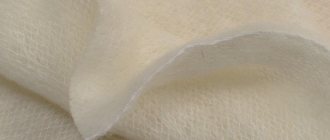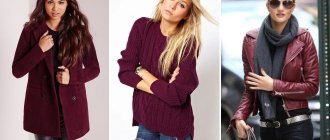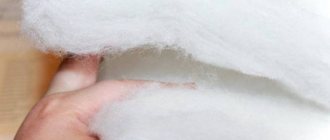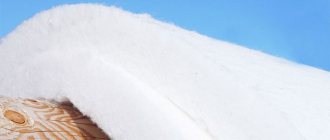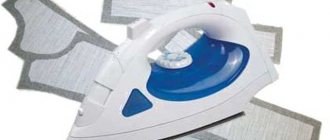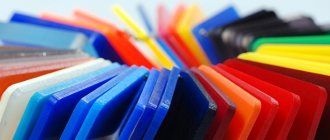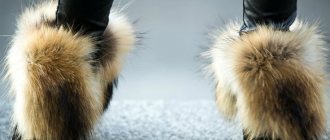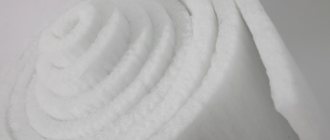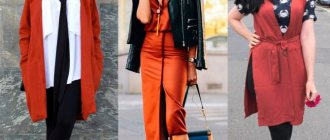If your clothes have ORSOTERM insulation, then they are light, comfortable, durable, hypoallergenic, environmentally friendly and profitable.
In clothes with ORSOTERM insulation, a person can feel comfortable even in severe frosts. Air is the best thermal insulator, and the more air “cavities” there are in the non-woven material, the lower the temperature this insulation can withstand.
Light but warm clothing with ORSOTERM insulation is indispensable when playing sports. It does not restrict movement, does not get wet, does not wrinkle and washes well. Doing physical activity in such clothes is a pleasure and has health benefits.
A thinner layer of insulation is perfect for demi-season clothing, when wind, rain and unstable weather can affect a person’s well-being. This is another property of the innovative insulation - wind protection. The hollow fibers of the material are made in such a way that cold air from the outside entering the insulation layer does not penetrate inside under the clothes, but is retained in the layer and gradually warms up there.
Those happy owners of outerwear with ORSOTERM insulation who have already appreciated it this winter season, share their impressions. Jackets and coats with ORSOTERM insulation are not inferior in quality to down jackets made with eiderdown. Warm, light and windproof.
ORSOTERM
- insulation produced using a new improved technology from highly crimped siliconized fibers in combination with unique additives, the main properties of which are lightness and frost resistance. Tests have shown that the special production technology of ORSOTERM non-woven insulation fabric in the form of crimped fibers creates an air layer in the fabric itself that retains heat.
Frost resistance is not the only quality inherent in the new generation of ORSOTERM insulation. Also, due to the special technology of weaving and crimping of the hollow fibers of the non-woven fabric, the lightness of the material is achieved. The air gap does not create the slightest weight. This is very convenient for winter or autumn-spring outerwear.
The non-woven material in the products fully meets the conditions of thermal comfort for humans, the level of protection, makes everyday life easier, creating ease of use.
All products that are made using modern non-woven material ORSOTERM can serve as an example of sanitary standards. They are easy to wash and wash at home - in the washing machine or by hand. Due to the original curl of the fibers and the large air gap of the material, the volume of the product is quickly restored, and the drying process takes a minimum amount of time.
Test studies, which were carried out for several years before introducing the innovative technology to the masses, showed that repeated washing, various twisting and stretching of ORSOTERM insulation and products made from it do not lead to shrinkage, tears and other deformations of the product.
For allergy sufferers, ORSOTERM can become a “saving straw” - the material is hypoallergenic and does not cause irritation to the upper respiratory tract or skin reactions. An excellent opportunity to adapt ORSOTERM fibers in the production of goods for children - clothing, toys and furniture.
ORSOTERM fibers have no odor, do not emit any harmful substances into the atmosphere and do not negatively affect the environment. Experiments have shown that the environmental properties of the material are not satisfactory.
Density 200g/m2 up to -15 Density 300g/m2 up to – 25
Negative reviews
Terrible coat. Doesn't heat up at all. It blows through. But it’s impossible to stay indoors—you instantly become all wet. It’s not clear what weather to wear: it’s cold even at +5. Very sorry for the money wasted.
I also once bought myself a demi-season HOOPS coat with padding polyester. The quality is disgusting. After a week, the lining was so torn that it was simply impossible to put on the coat - just rags inside, padding polyester in shreds in all directions, I couldn’t even get my hand into the sleeve)) The seams on the outside also began to come apart after 2-3 weeks. Honestly, Chinese clothes are probably of better quality. And it quickly lost its shape, although I didn’t wash it, it began to hang like a bag. Of course, I didn’t expect such a surprise, because the price cannot be called low. In general, I will never buy clothes from this brand again and I don’t recommend it to you
Advantages:
Beautiful color and model
Flaws:
The coat only lasted for 1 fall.
And last year, I ordered an autumn coat from the website as part of a promotion. I didn't have to wear it for long, because after 2-3 washes the seams on the lining came out and I had to hem it every time. But the climax of everything was the zipper, at the very bottom it came off from the very clamp and in order to fasten it, you had to be patient, since nothing worked the first time. Dear manufacturers, I urge you not to skimp on extra threads for processing the lining and, of course, on accessories.
I recently placed an order for 3 units, all of the same marking 44, when the goods were delivered, one coat was very tiny, one was simply huge, and only one was the right size!
Modern types of insulation.
We live in a happy time, when modern technologies are developing by leaps and bounds and what was previously available only to a select few is becoming accessible and firmly integrated into the everyday life of ordinary people. The same, of course, applies to modern materials that are used in sportswear. Now you can choose clothes for any type of activity that will meet all the requirements necessary for exercise, and accordingly provide maximum comfort and safety.
When active in cold weather conditions, it is very important to properly insulate - so that the body not only warms up, but also not overheats and breathes during activities - be it just walking in the fresh air or racing cross-country skis. In this article we will talk about modern insulation materials - what manufacturers offer, what they focus on and what is best to choose. Nowadays there is a huge number of insulation materials on the market, which are often not so easy to understand.
All insulation materials can be divided into two classes - natural
(
down, wool
) and
artificial
(
primaloft, thinsulate
and so on).
Neutral reviews
I bought this coat through an online store, so I judged its quality only from photographs and reviews from other customers. Overall I was pleased, but some points still upset me a little. For example, the fact that there are no knitted cuffs on the sleeves, as well as the quality of the fur on the hood. On the sides it is very fluffy and beautiful, but on the back there is much less fur. It's kind of flattened. I really liked the fabric of the top of the coat. It repels water well. I ironed my coat before putting it on for the first time. If water from the iron got on it, it immediately rolled up into a ball and was not absorbed at all.
Advantages:
Flaws:
Same description for completely different models. Not very high quality tailoring!
My mother and I jointly ordered an insulated raincoat from Hoops! Mom ordered this one: According to the description, it is suitable for temperatures from +5 to +15. But my mother practically doesn’t wear it, since the raincoat looks like a down jacket, and it’s somehow strange to go outside in warm weather in a “down jacket.” And when it gets a little cool and the wind blows, it’s very cold there. He looks handsome and pleasant. But it hangs very ill-fitting. I had to buy a belt; when walking, the fabric of the raincoat slides up from under the belt.
Since my mother is not tall, it is also long and restricts her movements in the knees (you just step on a step on the bus) But I am pleased that I ordered this insulated raincoat for myself: It is very similar in description to my mother’s raincoat. But! The quality is completely different! It's warm! I wear it in minus 15 degrees! And unlike the first raincoat, it looks like a raincoat, not a down jacket. But it's the other way around. Mom is cold in her Down Jacket, but I am hot in my raincoat. But I'm happy with my purchase. The raincoat is not blown at all, despite the fact that it is not made of fashionable microfiber. At the back it is adjustable at the waist level with laces. It is beautiful and really captivated me with its hood and checkered cuffs on the sleeves. So, after all, it’s probably best not to buy a pig in a poke when the thing is not cheap) But personally, I was satisfied!
Positive reviews
Advantages:
Flaws:
My first purchase was an insulated raincoat, I bought it in 2012 and was very pleased with it, the thin synthetic padding warmed me up well on cool autumn days, I washed everything in the machine on a gentle wash. My second purchase was a winter coat, also in 2013, I’m absolutely delighted with it, the fur on the hood is very fluffy and it’s very warm, it didn’t freeze even at -30 and it’s also very bright 3 my purchase was again an insulated raincoat, I already bought it in 2014 I decided to buy it in a sporty style and was again very pleased with it. I would like to note that not a single item had any threads sticking out, no buttons fell off, and the locks were of excellent quality! The stitching is also all even, some models came with winter belts, there were even two regular ones in the color of the coat and a rubber strap. All models fit true to size. I recommend purchasing clothes from this company and I will continue to buy clothes from this company with great pleasure!
Good quality, true to size. Great jacket.
The jacket is unusually light, just right for spring. The color, unlike the photo, is the lightest, which was very pleasing. Fits perfectly, according to the figure!
Advantages:
Flaws:
I am very pleased with the work of this company. I bought a coat in September, and put it in the closet until it got cold, but then winter comes, I took out the coat, and there was a defect, a seam defect on the sleeve, and when you put it on it was quite noticeable. I was terribly upset, a month has already passed since the purchase and I bought it from the sale section, but the website says that items from the sale section cannot be exchanged or returned. I was upset for several days, I was already looking for where they do clothing repairs, but I decided to call the store. The girls from the store gave me the manager's phone number, she called me, explained the situation, and sent me a photo of the seam. And the next day they called me and said that they were ready to exchange. I am very pleased, even though my color was not available, they replaced it with another one, but without defects. Now in winter I will test it for warmth, it says up to -25. What attracted me was that it is not fluff, which is difficult to wash, and is very light and thin. In general, I recommend it to everyone, the company is good, values its name and works honestly.
I liked the jacket, light and warm. I hope it wears well. I like the styles of this brand. Thank you.
Advantages:
warm, inexpensive, made in Russia
Flaws:
I bought this coat back in the fall, preparing in advance for the winter cold. We were able to really test how warm this jacket is in cold weather not so long ago, since the temperature outside was no lower than 10 degrees on average.
By the way, I had to say that before this I had an autumn jacket from the same company, I treated it well and it still served after me. During service, it did not cause any complaints, it was machine washed, it only faded a little and that’s all. Her color was bright blue with mother-of-pearl.
Returning to my winter coat, I can say that it is exactly the same as shown in the picture of the item being reviewed, only gray.
We bought it on the Internet and it cost us 1,200 rubles, which is very cheap when you consider how much winter jackets cost in regular stores. Hoops is a Russian company, which is also good.
Here's my coat.
Looks better on me.
The coat is long, which is important for winter - it does not blow and at the same time protects the legs (hips) from the cold. The hood has fur (faux). When you fasten the jacket with a button in the throat area, this fur covers the throat well and I can easily do without a scarf all winter. But at the same time, it is very inconvenient; if you put the hood on your head, this fur slides down onto your face. I don’t really like buttons, because you always have to fasten them all, otherwise it won’t look nice. Well, there’s another small minus - the jacket is not light.
The sleeves have knitted cuffs and there is no air in the sleeves. The belt is textile and very long - it takes a long time to fasten it and then the end needs to be wrapped somewhere else, because it is long. otherwise it will hang on the side. And that’s why I just bought an elastic belt, it’s much easier with it.
The pockets are soft and warm, but in windy weather your hands will freeze there and the pockets are very drafty.
If you need it, there are drawstrings at the bottom (I didn’t use them).
The filling of the jacket is new - Orsotherm. It is briefly and clearly written about on the label.
Having worn it in cold weather, I can say that it is quite normal for winter, I don’t freeze in it. The pockets may be ventilated, but the coat itself is not. The small disadvantages described above are specific only to a specific model, and therefore do not relate to the quality of the coat as a whole. During wearing, it did not tear or come apart anywhere, all the fittings are in place.
Artificial insulation
A good alternative to down is artificial insulation. Since Sintepon
, which was not a particularly high-quality insulation, the opinion was formed that all non-natural insulation materials work poorly.
But at the moment, technology has gone far ahead and manufacturers can offer an excellent alternative to down, allowing them to satisfy the most demanding consumer. Now a large number of manufacturers have appeared on the market who specialize only in the production of such materials. But sportswear manufacturers often use their own designs. At the moment, the market leaders of artificial insulation in sportswear have been identified - these are Primaloft
from
Albany International
and
Thinsulate
from
3M
.
| Primaloft is a company that has been developing for over 25 years and is one of the leading industry leaders. Initially, the company's task was to produce insulation for the American army, which could become a replacement for natural down. The company produces a huge number of types of insulation, all of them have the following basic properties: |
- high ratio of thermal insulation properties to weight (no need for a thick layer of clothing for good thermal insulation). That is, the material is light and warm.
- breathes well (allows fumes to escape)
- waterproof
- soft
Now there are three series of insulation - Gold; Silver; Black
, each of which contains 5 to 10 types of insulation.
Where and how was thermofin invented and produced?
Russian thermofin is produced, but the technology for its production belongs to Finnish engineers. Specialists from TTI University (Tampere, Finland) and Termoreal have been working on the creation of this insulation for a long time. The task was to invent a material specifically for the climatic conditions of Russia. As a result, clothes with this filler can provide warmth at fairly low temperatures – down to –50°C.
Later, termofinn passed the relevant tests and was highly praised by specialists from Oeko-Tex Standard 100, a global organization for testing and certification of textile products. This material is assigned the highest class I, which means it is suitable for use by children under 2 years of age. Now thermofin is produced on an industrial scale using the latest German-made equipment.
This material has a wide range of applications. Today it is used for sewing winter clothes for children and adults, and products for sports. They make uniforms out of it for employees of various companies who are forced to spend their working hours outside. In addition, thermofin is used to fill bedding - pillows, blankets, mattresses, as well as products for newborns (warm covers for strollers, baby carriers, etc.).
Properties of thermofin insulation
The insulation is created using a unique technology, thermally gluing two types of fibers - conventional and bicomponent. The latter consist of two types of polymers, which shrink differently during the production of fibers, which leads to increased crimp of the thread. As a result of a number of manipulations - combing the fibers, heating, etc. - a light and airy fabric with a porous structure is obtained. The raw materials for making the filler are delivered from South Korea.
Thanks to the low-melting shell of the bicomponent fiber, gluing occurs instantly. Special software controls the temperature in the furnaces, preventing overheating and significant compaction of the material. Next, the blade passes through cutting shafts to create smooth edges. The finished product is subject to vacuumization before being sent for sale or production, which allows for maximum preservation of its properties.
Despite the high demand for this fiber, the manufacturing company continues to improve its products. In 2013, the first batch of termofinn plus was launched on the market. This is a product that has undergone a calendering procedure, which has reduced the migration (movement) of fibers. At the same time, such a fabric becomes less soft and elastic.
In 2014, another type of product appeared - termofinn micro. Super-thin threads are used to make it, which leads to the formation of many air cells. This significantly enhances the thermal insulation properties of the material. Experts continue to work on new types of product to make it as cheap as possible and make it even warmer.
The insulation has a number of advantages over analogues. Main characteristics:
- Eco-friendly and safe. Does not cause allergies, does not absorb odors.
- Gives very slight shrinkage when wet - up to 0.2%.
- Wear-resistant. Retains its shape and elasticity after many washes.
- It is light in weight and retains heat well.
- Termofin is not calendered, so it does not have an outer dense “crust”. Due to this, the fabric is very soft and flexible.
- Thanks to a fully automated production line controlled by computers, the material has a uniform structure and is free from such defects as dents, bald spots, and thickening.
- The cost of this canvas is lower than that of analogues, since production is located in Russia.
Natural insulation materials
Pooh
has always been considered the best insulation, and manufacturers of artificial insulation consider down to be the reference material, a guideline in the production of artificial fillers.
Main characteristics of down:
- A light weight
- High heat retention
- Good breathability
- Elasticity (recovery to original volume)
The best down is eiderdown
, but there is very little of it on the market - since this type of down is very expensive and is obtained in strictly limited quantities, in the wild.
The most popular type of down is goose down
.
And of course, the best goose down comes from northern countries, where climatic conditions allow the production of lighter, warmer and fluffier natural insulation. One of the main characteristics of down is the FP - Fill Power
. This is a measure of how much down recovers its original volume after being compressed. The higher this indicator, the better the down, more durable, warmer and lighter. You can focus on the following digital designations:
- up to 400 - poor quality fluff
- 400 - 450 - medium quality fluff
- 500-750 - excellent quality down
- 750 and above - extra class down
Many manufacturers, caring about product quality and the environment, adhere to the RDS
, which indicates that the fluff was collected from healthy animals raised in comfortable conditions, and no significant harm was caused to the animals. With all the positive characteristics, down filling also has its disadvantages. So, for example, down products are quite difficult to care for and store. As a rule, they are expensive, and an allergic reaction is possible.
What temperature are thermofins of different densities designed for?
The main density parameters are presented in the table:
| Density, g/m² | Blade thickness, mm | Temperature, °C | Heat retention characteristics (clo) |
| 100 | 1,2 | Up to 15 | 1,5 |
| 150 | 2,2 | Up to –22 | 2,1 |
| 200 | 2,7 | Up to –30 | 3 |
| 100+100 (double layer) | 2,4 | Up to –30 | 3,2 |
| 100+150 | 3,4 | Up to –35 | 3,8 |
| 150+150 | 4,4 | Up to –40 | 4,6 |
| 200+200 | 4,6 | Up to 50 | 6 |
The table shows the heat-retaining ability of thermofin - this indicator is needed to assess how easily warm air passes through the filler. The larger it is, the more efficiently the canvas retains heat.
Some down jackets and jackets are made with a double layer of insulation. This means that the data from the table needs to be multiplied by two to get the actual thickness of the material. At the same time, its ability to retain heat also increases. The outer and lining fabric of the product provide additional protection and help retain warm air.
How to care for clothes with thermofin insulation?
Due to its characteristics and high wear resistance, thermofin does not require special care. Items with this filling can be washed in an automatic machine on a delicate cycle at a temperature of 30–40°C. It is worth paying attention to the fabric that was used to sew the product. For example, fabric with a moisture-proof coating does not tolerate washing well; it is better to dry clean such jackets.
It is important to choose the right detergent. You will have to exclude products that contain bleaching components, as well as powders. It is better to use gels or other liquid detergents. In this case, there will be no white spots or streaks left on the surface of the product. In this case, if there are stains on the front side of the jacket, it is permissible to use an oxygen-containing stain remover.
After washing, the jacket or down jacket should be hung up, straightened out well, so that creases do not form during drying. It is better not to iron products, but if this is necessary, you need to set the device to minimum heat.
Types of fillings in jackets
What is polyester in a jacket? When buying a coat or other outerwear, people primarily focus on the weather and climate of their region. But this may not be enough, because polyester in jackets has different properties. You can ask a store consultant for more information about padding. Information about this is indicated on the tag. There are fillers that are easy to distinguish by tactile sensations (for example, padding polyester).
Thinsulate
Down of artificial origin, which in its properties differs little from natural fluff. Thinsulate was used to insulate astronaut suits. Today they are used to stuff winter clothes for sailors and sleeping bags for mountaineers. To what temperature is polyester suitable? Things insulated with Thinsulate can be worn at 30-60 degrees below zero. It all depends on how dense the layer is. The stuffing is suitable for sewing children's clothes. Thinsulate fiber produces lightweight and at the same time warm clothing that is highly breathable.
Its density is 100-480 g/m². Due to its softness and light weight, Thinsulate is in many ways similar to swan's down. It is in many ways identical to natural, but does not cause allergies. Thinsulate consists of microfibers that are surrounded by air membranes. This polyester insulation is thin enough, so you can sew elegant winter coats from it. Things made from this filler have one drawback - the high price.
Holofiber
Holofiber does not absorb moisture, as it quickly evaporates from it. At the same time, warmth can be retained in clothing. There are halofiber balls inside the outer sides of the material. This polyester jacket will keep you from freezing and sweating. The raw materials are used to sew children's clothes. It is safe for allergy sufferers and suitable for everyone. The properties of holofiber largely imitate down. It can withstand machine washing on a delicate cycle.
The density of the material ranges from 70 to 300 g/m². How many degrees is holofiber suitable for? It is recommended to wear it at temperatures from 5 degrees Celsius to 30 degrees below zero. It is wear-resistant and does not lose its thermal insulation properties for a long time. Winter jackets made from holofiber can be worn in low temperatures and strong gusts of wind.
Sintepon
At one time, the structure of this material was changed, and since then it has been used in the production of jackets and coats. Sintepon 150 g/m² is the minimum density of the material, the highest is 400 g/m². It perfectly retains its shape and retains heat; items made from it are sold at reasonable prices. Many people are interested in what temperature is a padding polyester 200 g m2 designed for? It is recommended to wear things with such padding at the end of autumn or at the very beginning of winter, if the temperature has not dropped to 10 degrees below zero. Things that can be worn at 25 degrees below zero are insulated with padding polyester with a density of 350 g per m².
Sintepooh
This polyester insulation is reminiscent of bird down in its properties. The polyester fiber in it is glued in it in a special way. Synthetic fluff is wear-resistant, does not wrinkle, and dries quickly. For the winter months, when the temperature drops to 25 degrees, you can wear jackets with synthetic down, the density of which is 250 g/m². In five-degree frost, a filler with a density of 60 g/m² is sufficient. According to its structure, such polyester insulation can be homogeneous or elastic.
Isosoft
This material comes in different types. One of them is isosoft, the fibers of which are made in the form of balls. It is easy to care for: after washing it dries quickly and is not subject to deformation in the machine. Isosoft is thin enough, so down jackets made from it do not look bulky. Density ranges from 80 to 300 g/m². At the same time, the layer retains heat well. It is several times better than synthetic winterizer in its thermal insulation properties.
Isosoft is very soft and elastic, wear-resistant and at the same time breathable. A relatively thin layer of isosoft will prevent you from freezing in frosty weather. You can wear a coat with this insulation both in winter and in the off-season.
Manufacturers advise you to find out the density of isosoft and at what temperature it can be worn:
- from 200 to 300 g/m² – severe winter up to 35 degrees below zero;
- from 100 to 150 g/m² – up to 10 degrees below zero;
- from 40 to 80 g/m² – not lower than 0 degrees.
To improve the thermal insulation characteristics of isosoft, you need to put something thick under your coat (for example, a fleece sweater). This is how you can insulate a demi-season down jacket made of isosoft if the weather unexpectedly changed on a trip and you didn’t have any warmer things with you.
Certain types of polyester linings are suitable for different temperatures and weather. When purchasing items with synthetic padding, it is worth asking a consultant about how and what the interlayer is made of, what its density is, as well as other properties.
Experts advise asking what brand of outerwear is and reading reviews. The main thing is to know at what temperature you can wear it, what the density is, whether it can withstand machine washing and what the quality of the layer is.
